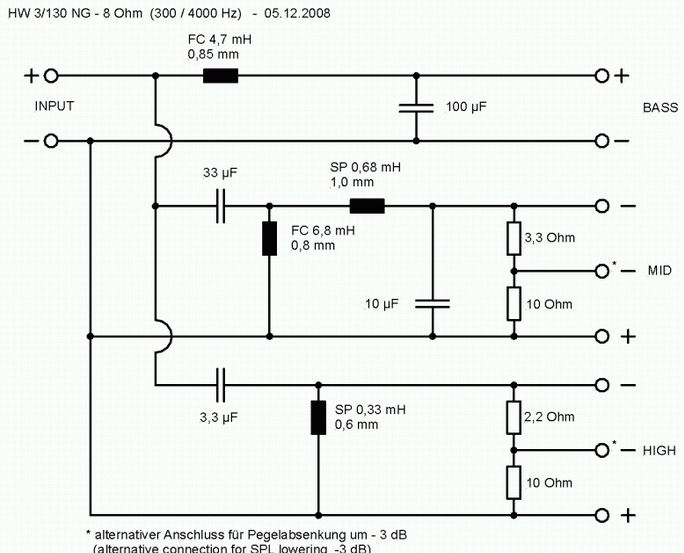While essentially true, the way out of this tends to become lost in the practical details when implemented with a versatile technique, such that a passive crossover is.These schematics contain an often made mistake. First stage should cross over between low an mid/high. Then this hi/mid stream should be crossed between high and mid.
For those unfamiliar, the bandpass mid has two filters which interact, and the tweeter filter requires compensating.
When the response and phase are simmed to meet the typical targets, as with conventional passive crossover design (or equivalent active), this compensation is built into the result, by way of slightly different component values.
When using purely textbook (ie named) filters, this problem requires separate attention. An all-pass filter could be added to the tweeter cross, in addition to the normal high-pass and equalisation.
In the cascaded case as suggested, the mid would first need to be set up for the standard bandpass response. Approaching the issue from this alternate angle would first require impedance compensation on the driver, and moving left, one of the filters, then impedance compensation again, then the other filter (not to mention EQ). The tweeter would be tapped off at the leftmost impedance compensation, which needs to compensate the effect of both of the drivers and their crossovers after that point.. not to mention that when you change one, the other changes as well.
The upshot of this is that you use more components and have a more difficult time designing it to get essentially the same result.
I think everyone is being far too gloomy here. This Visaton off-the-shelf is about as good as anything I have seen. 
When you use attenuators on mids and tweeters, you are inadvertently doing impedance compensation. Basses don't need it much since you are not at frequencies where inductance starts to fight your filtering efforts.

Given reasonably flat drivers it works superbly well with most drivers I have thrown at it in simulations. All you've got to do is adjust 4 resistors.
Possibly you'd use a third order on the tweeter on a flat baffle to get phase better aligned, But are you really going to hear it much? As it goes, I think 90 degree phase has strengths in flat power output.
And if you have a stepped baffle, you'd flip the tweeter polarity:
ScanSpeak-3W-Discovery
The perfect is the enemy of the good, because it never arrives, they say. Well, this Visaton filter is good IMO.
When you use attenuators on mids and tweeters, you are inadvertently doing impedance compensation. Basses don't need it much since you are not at frequencies where inductance starts to fight your filtering efforts.
Given reasonably flat drivers it works superbly well with most drivers I have thrown at it in simulations. All you've got to do is adjust 4 resistors.
Possibly you'd use a third order on the tweeter on a flat baffle to get phase better aligned, But are you really going to hear it much? As it goes, I think 90 degree phase has strengths in flat power output.
And if you have a stepped baffle, you'd flip the tweeter polarity:
ScanSpeak-3W-Discovery
The perfect is the enemy of the good, because it never arrives, they say. Well, this Visaton filter is good IMO.
Last edited:
Yes, or part of 90 degrees thereof, when carefully calculated and implemented. Can sound better than merely lining up phase.But are you really going to hear it much? As it goes, I think 90 degree phase has strengths in flat power output.
- Status
- This old topic is closed. If you want to reopen this topic, contact a moderator using the "Report Post" button.